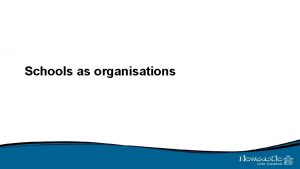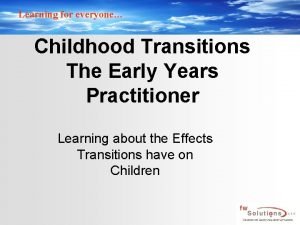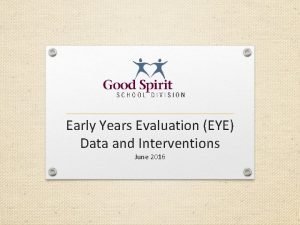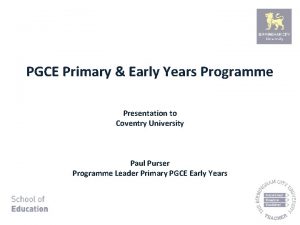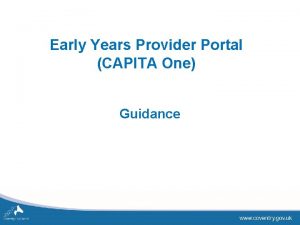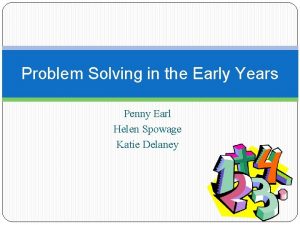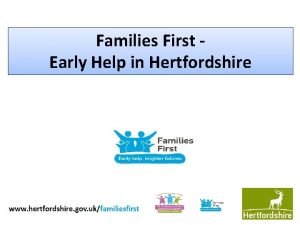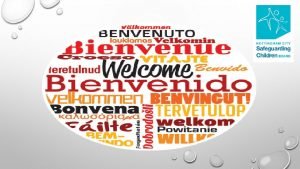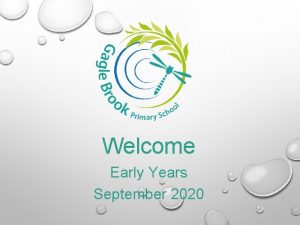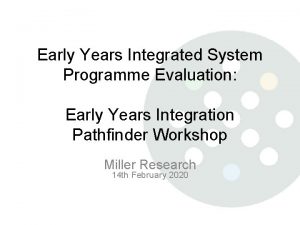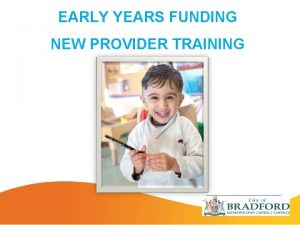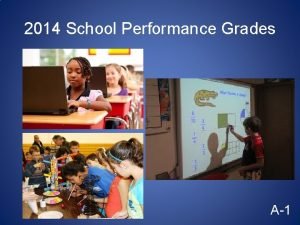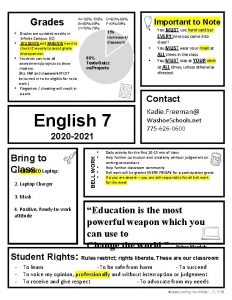THE EARLY YEARS AND THE EARLY GRADES Early

























- Slides: 25

THE EARLY YEARS AND THE EARLY GRADES Early Childhood Education Through a Cultural Lens Felicia De. Haney, Ph. D.

WHERE ARE WE NOW? One third (33%) of kindergarteners in Maryland are African -American. 79% of African-American children are fully school-ready in 2012 -2013, up from 37% in 2001 -2002. This is a 42 -point jump – substantially higher than the State’s overall readiness gain. Reduces the school-readiness gap between African. American and White children from 19 points to 9 points (88% of White students are fully school-ready). Ready at Five MD

WHAT HAPPENS IN K-3? 72. 7% of Black/African-American children scored “Advanced/Proficient, ” according to the 2013 MSA results in reading Down nearly 3 percentage points from 2011 Still an 18 -point gap between African-American children and White children (who are 90. 5 % Advanced/Proficient) 10. 8% of Black children scored “Advanced, ” compared to 22. 1% of all students and 32. 2% of White students 27. 3% scored “Basic. ” compared to 17. 4% of all students and 9. 5% of White students

GREAT SUCCESS CAN BE FOUND! There are schools where Black children are scoring at the same level as their White peers! In schools where Black children make up at least 33% of the student test-takers, there are three schools in Baltimore where over 95% of Black children are scoring in the “Advanced/Proficient” range: Wellwood Elementary School (50. 9% Black) Chadwick Elementary School (52. 1% Black) Cedarmere Elementary School (45. 2% Black) There an additional 17 elementary schools throughout Maryland where over 95% of Black children are scoring that high, but their Black children make up 20% or less of the student population of test-takers.

HOW TO MAKE EARLY CHILDHOOD SYSTEMS AND CLASSROOMS MORE MEANINGFUL FOR CHILDREN OF COLOR: FOUR CRITICAL STRATEGIES Positive Relationship Development Strong Family and Community Engagement Importance of Social-Emotional Development Successful, Supportive and Seamless Transitions

POSITIVE RELATIONSHIP DEVELOPMENT BETWEEN CHILDREN AND TEACHERS The relationship a child has with a teacher or caregiver…is the central and most critical component of quality (Zaslow, 2010) Teacher-reported closeness with students was positively related to growth in children’s receptive vocabulary and reading abilities from preschool to second grade, especially for children of color. (Ray, Bowman and Brownell, 2006) The performance of African-Americans, more so than other students, is influenced to a large degree by the social support and encouragement they receive from teachers. (Noguera, 2008) Researchers on effective schools for low-income African. American students cite the supportive relations that exist between teachers and students and the ethos of caring and accountability that pervades such schools as essential ingredients of their success. (Noguera, 2008) WHY?

Relationship Building in a Cultural Context Teachers, across races, expect less, on average, from Black students than Whites. Relationship development which helps to raise expectations will benefit children’s achievement because teachers hold higher standards for students they expect to perform at higher levels. (Ferguson, 2007) “Beliefs about what constitutes good teaching vary across different cultural communities. Mainstream thinking holds that teaching begins with teachers’ awareness of and ability to transfer knowledge. However…many [teachers from communities of color] believe teaching begins instead with the establishment of relationships between themselves and their students. ” (Delpit, 2006)

WHO SAID THIS? Learning and performance contexts that are more responsive to children’s familiar and existing home and cultural experiences facilitate cognitive functioning and, consequently, achievement. “When we put interventions in place for a student of color based on our own White, middle-class perspectives and the intervention doesn’t work, we then unconsciously or sometimes consciously say, ‘Well see, we did this fabulous intervention and it didn’t work. It must be the kids. ” “This is very difficult work because teachers tend to deny, defend or shut down when you bring up issues of race. They’ve chosen this profession because they want to help children, but what is not understood is that despite our good intention, our teaching practices don’t always have a positive impact on the student. ”

HOW DO SCHOOLS PRIORITIZE RELATIONSHIP DEVELOPMENT? Low teacher-child ratios. Facilitate professional development opportunities and conversations that include discussions of race, class and culture. Support the recruitment of an increasingly diverse teacher workforce, seeking out and promoting talent from within schools and surrounding communities. Support teachers to identify and engage in a range of classroom management strategies that specifically support the learning of Black students (See Wade Boykin and Lisa Delpit) “A classroom that allows for greater movement and interaction will better facilitate the learning and social styles of African-American boys, while one that disallows such activity will unduly penalize them. ” WHAT CAN YOU DO?

STRONG FAMILY AND COMMUNITY ENGAGEMENT Family engagement should be “a systemic and sustained commitment that occurs across time, spans many settings, and requires shared responsibility from all parties. ” (Harvard Family Research Project, 2009) “High-performing schools maintain strong communication with families, but low-performing schools are weak in communication and family engagement. Given the importance of family contributions in the education of their children, the preparation of teachers for family engagement becomes not only an issue of good practice, but also one of equity. ” (Civic Enterprises)

WHY DO WE STRUGGLE? “More often than not…at urban public schools, parents are described as uncaring, dysfunctional, unsupportive and. . . as obstacles in the way of progress and problems to be overcome. ” (Noguera, 2008) Current policies and practices at the federal, state, district, school and program levels rarely provide sufficient support to teachers or to parents. No one is held accountable for comprehensively and consistently engaging a diverse range of families.

HOW CAN WE CHANGE? Learn about the context of race and culture bias in which our children and families are embedded. Make conscious decisions about engaging with family and community members in ways that demonstrate a deeper and more complete understanding. Create a climate in the school where it is comfortable to talk about race and culture as a piece of children’s development. “Educators need to know that for parents of Black boys, resisting the relentless rumors of inferiority about our children and about ourselves as parents is exhausting. ” - Ward (2008)

BEST PRACTICE: FLAMBOYAN FOUNDATION Building effective family engagement strategies to improve academic achievement The impact of family engagement strategies range from celebrations on the low end to parent-teacher conferences in the middle and regular, personalized communication with home visits at the high end. Some strategies work better than others – and cost more too. What kind of outcomes do the higher-impact strategies achieve?



POLICY IMPLICATIONS Establish program standards related to culturally-relevant family engagement Establish supports for higher education, professional development programs, and teacher education programs to include coursework on culturally relevant family engagement Invest in home visiting (congratulations on the passage of the Home Visiting Expansion and Accountability Act!) Collect and report data on discipline measures taken even with the youngest children, disaggregated by race, to assess whether or not patterns of disproportionality are emerging in the earliest years. Collect and report data on family structures that is not limited to the categories of either “single parent” or “two married parents, ” which doesn’t address the myriad ways in which fathers of color, in particular, are involved in their children’s lives.

IMPORTANCE OF SOCIAL-EMOTIONAL DEVELOPMENT “African-American kids have moral strengths that have been obscured by the stereotypes. ” (Weissbourd, 2011) Many White children describe Black children as more honest, less hypocritical, more independent-minded, more willing to assert their views, and as less concerned about popularity than about respect in comparison with their peers. Independent-minded Defiant, disruptive Willing to assert their views Oppositional, aggressive Special education Suspensions Expulsions

SUPPORTING MORAL DEVELOPMENT How can schools educating children of color support moral development in ways that reflect the strengths and expectations of their children’s cultural, familial and communal context – instead of trying to change it? “Efforts to improve the academic performance of African-American males must begin by understanding the attitudes that influence how they perceive schooling and academic pursuits. To the extent that this does not happen, attempts to help Black males based primarily on the sensibilities of those who initiate them are unlikely to be effective and may be no more successful than campaigns that attempt to reduce drug use or violence by urging kids to “just say no. ” (Noguera, 2008) “In order to increase moral behavior, it is best to examine it in connection to racial identity development. ” (Ward, 2008)

SOMETIMES SMALL THINGS AREN’T SMALL Write and share a statement that clearly defines the school’s position on the importance of the child’s home, and the school’s commitment to learning about and integrating children’s culture. Welcome children’s extended family members, and explicitly invite them to participate in school events. Take inventory of all educational materials to determine if Black children and their families will recognize themselves in the environment; if not, make some changes. Expand vary the means of communication to include the use of email, Facebook and texts. WHAT CAN YOU DO?

EXAMPLE: MARYLAND’S VOCABULARY IMPROVEMENT AND ORAL LANGUAGE ENRICHMENT THROUGH STORIES (VIOLETS) This early childhood curriculum is designed to develop oral language, pre-literacy skills, and background knowledge in young (ages 3 -5) English Language Learners (ELLs) and children with low expressive language skills. The curriculum uses 12 Big Book versions of popular children’s books, chosen based on their quality, their appeal to young children, and the extent to which their content aligns with state pre-kindergarten standards in the domains of physical development, language and literacy, social and emotional development, mathematical thinking, scientific thinking, social studies, and the arts.

WHAT’S MISSING? Bread and Jam for Francis Down by the Station (White (Animal) people) Chrysanthemum (White girl) A Mother for Choco (Animal) Corduroy (Animal) My Five Senses (Asian child) The Doorbell Rang (White family) The Napping House (White girl) Silly Sally (White girl) Stellaluna (Animal) This Is The Way We Go To School (Diverse group of children) What I Like About Me (Diverse group of children)

CREATING A POSITIVE SCHOOL CLIMATE “A positive school climate is especially important for African- American and low socio-economic status students. ” (Haynes et al, 1997) “African-American children in the 3 rd grade viewed teacher-child relationships as the most important dimension of school climate. For them, caring teachers listened to them, were available to comfort and help with school and personal problems, and acknowledged their best efforts. ” (Slaughter-Defoe and Glinart. Carson, 1996) “Motivation in African-American children from low socio-economic groups is more influenced by the need for affiliation than for achievement. ” (Boykin, 2000) WHAT CAN YOU DO?

SUCCESSFUL, SUPPORTIVE AND SEAMLESS TRANSITIONS Half of young children experience some difficulty adjusting to school, while problems are even more prevalent among children from low-income families (Pianta et al, 2000) Black children consistently exhibit the highest mobility rates of all racial/ethnic groups. Overall, only 45 percent of Black third graders are enrolled in their kindergarten school, as compared to nearly 60 percent of White and Asian third graders (Burkham et al, 2009) Little indication that schools or districts implement any type of systematic approach to supporting teachers of mobile children or to easing the transition of children who are new to a school (Kerbow et al, 2003)

BEING BLACK IS NOT A RISK FACTOR: A STRENGTHS-BASED LOOK AT THE STATE OF THE BLACK CHILD Challenge the prevailing discourse about Black children – one which overemphasizes limitations and deficits and does not draw upon the considerable strengths, assets and resilience demonstrated by our children, families and communities. Weaves together three critical elements: Essays from experts that focus on using our children’s, families’ and communities’ strengths to improve outcomes for Black children 7 out of 10 essay contributors live and work in the Metro-DC area – use their expertise! “Points of Proof” from organizations that serve not as exceptions, but as examples of places where Black children and families are succeeding Data points indicating how our children and families are doing across a range of measures

QUESTIONS FOR DISCUSSION 1. Reflect honestly on your work with culturally and linguistically diverse children. Are there ways in which you fall into “risk factor” thinking about the children you serve—either in your perceptions of what they can accomplish or your expectations for their future? Discuss ways in which you may do this… 2. Turn it around and discuss some of the success stories for culturally and linguistic diverse children. Share some of your “points of proof” that provide evidence that minority children can be successful and that early childhood programs can make a different in their lives.
 Four scores and seven years ago
Four scores and seven years ago Sheep years to human years
Sheep years to human years 300 solar years to lunar years
300 solar years to lunar years Early years of william shakespeare
Early years of william shakespeare First photograph of a person
First photograph of a person Summarise types of early years provision
Summarise types of early years provision Medway early years
Medway early years Effects of transitions in early years
Effects of transitions in early years Bristol characteristics of effective learning
Bristol characteristics of effective learning Henry hudson netherlands
Henry hudson netherlands Sfyc hampshire
Sfyc hampshire Early years learning framework overview
Early years learning framework overview Eye early years evaluation
Eye early years evaluation Developmental milestones 40-65 years
Developmental milestones 40-65 years Pgce early years
Pgce early years Glasgow counts
Glasgow counts Coventry early years portal
Coventry early years portal Block play early years
Block play early years Picasso the early years
Picasso the early years Mark making early years
Mark making early years Partnership working in early years
Partnership working in early years Eyitt course
Eyitt course Penny earl and mark
Penny earl and mark Early help module
Early help module Early years summit
Early years summit Dsl nottingham
Dsl nottingham





